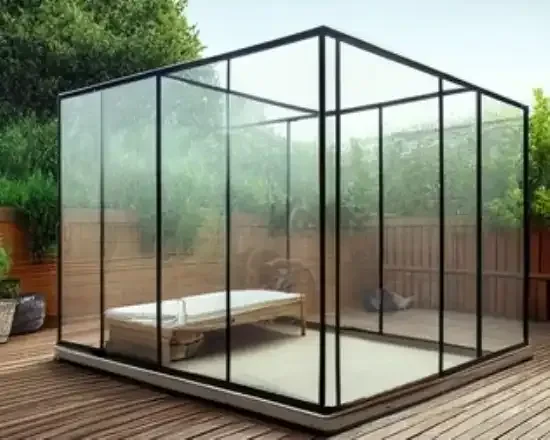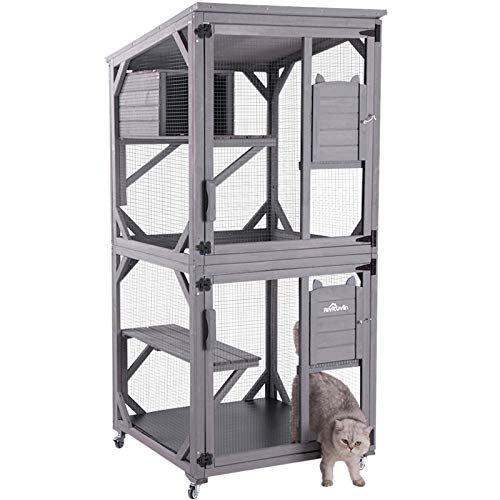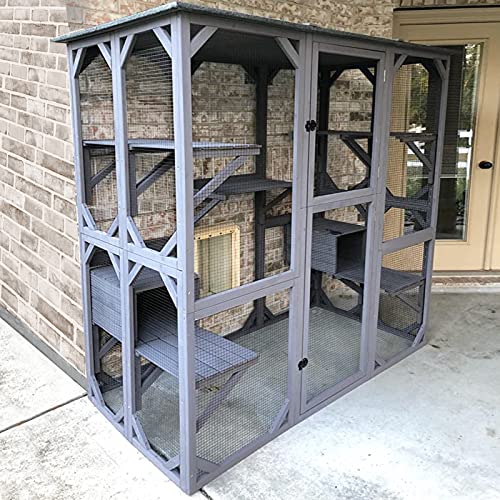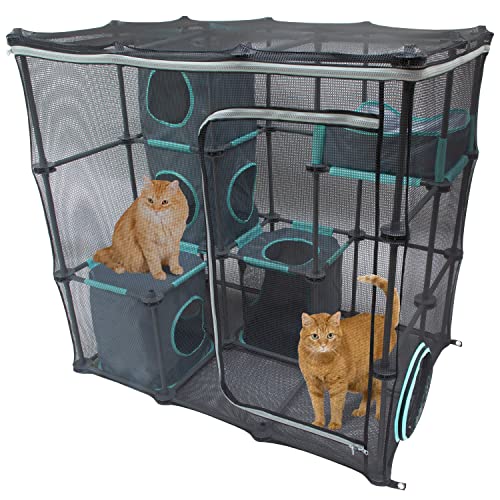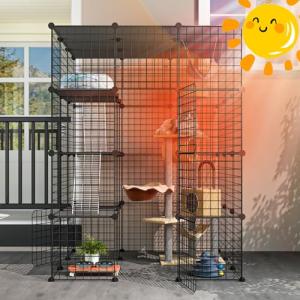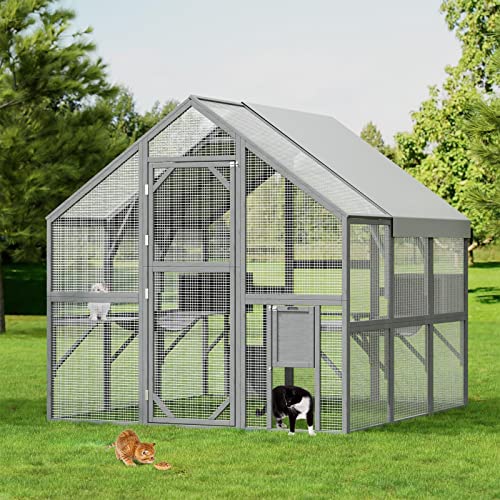In recent years, there has been a noticeable surge in the popularity of outdoor cat enclosures, reflecting a growing understanding of the importance of providing safe and enriching environments for our feline companions. Once confined solely to the indoors, more and more cat owners are recognizing the benefits of allowing their cats access to the outdoors while ensuring their safety through enclosed spaces.
The significance of outdoor cat enclosures lies in their ability to offer a compromise between the safety of indoor living and the natural instincts of cats to explore and enjoy the outdoors. These enclosures provide a controlled environment where cats can experience fresh air, sunshine, and sensory stimulation while being protected from potential dangers such as traffic, predators, and disease.
Throughout this article, we will delve into the world of outdoor cat enclosures, exploring their various designs, benefits, and considerations for building or purchasing one. From understanding the fundamentals of outdoor enclosures to practical tips for maintenance and upkeep, we aim to equip cat owners with the knowledge and resources to create safe and enjoyable outdoor spaces for their beloved pets.
Understanding Outdoor Cat Enclosures
Outdoor cat enclosures, also known as catios or cat runs, are specially designed structures that provide a safe and controlled outdoor environment for cats. These enclosures offer a compromise between indoor living and outdoor exploration, allowing cats to satisfy their natural instincts while minimizing the risks associated with roaming freely outdoors.
43ft² Wooden Outdoor Cat House with Cat Run
Provide your furry friends with their own outdoor kingdom in this spacious 43ft² wooden cat house and cat run
Product information
$499.99 $429.99
Product Review Score
4.88 out of 5 stars
96 reviewsProduct links
Definition and Purpose of Outdoor Cat Enclosures:
Outdoor cat enclosures serve as secure spaces where cats can experience the sights, sounds, and smells of the outdoors while remaining protected from potential dangers. They are typically constructed with sturdy materials such as wire mesh or wood and are designed to prevent cats from escaping or encountering hazards such as predators, traffic, or toxic plants. The primary purpose of these enclosures is to enhance the quality of life for indoor cats by providing them with opportunities for exercise, mental stimulation, and sensory enrichment.
Different Types of Enclosures:
Catios: Catios, a portmanteau of "cat" and "patio," are enclosed outdoor spaces attached to homes or apartments. They vary in size and design, ranging from small window boxes to expansive structures that encompass entire balconies or yards. Catios often feature shelves, ramps, and climbing structures to provide cats with vertical space and opportunities for exploration.
Outdoor Cat Runs: Outdoor cat runs are standalone structures erected in yards or gardens. They come in various shapes and sizes, such as tunnels, fenced-in areas, or fully enclosed pens. Cat runs may be constructed using wire mesh, fencing, or other secure materials and can be customized to suit the available space and terrain.
Catios Attached to Homes: Some catios are built as extensions of existing structures, such as screened-in porches or sunrooms. These catios offer seamless indoor-outdoor transitions, allowing cats to move freely between the enclosed space and the home while still benefiting from the safety and security of the enclosure.
Safety Considerations for Outdoor Enclosures:
Escape Prevention: Ensuring that the enclosure is escape-proof is crucial to prevent cats from wandering off or encountering hazards outside the enclosure.
Predator Protection: The enclosure should be designed to keep out predators such as coyotes, birds of prey, or stray animals that may pose a threat to cats.
Weather Protection: Providing adequate shelter and protection from extreme weather conditions, such as rain, heat, or cold, is essential for the comfort and well-being of cats.
Toxic Plant Awareness: Avoiding the use of toxic plants within or around the enclosure to prevent accidental ingestion by cats.
Supervision: While outdoor enclosures offer a safe environment for cats, it's important to supervise them during outdoor time to ensure their safety and well-being.
Understanding these key aspects of outdoor cat enclosures is essential for creating a safe and enriching outdoor environment for feline companions. By prioritizing safety and considering the specific needs of cats, owners can provide their pets with a fulfilling outdoor experience while maintaining peace of mind.
Benefits of Outdoor Cat Enclosures
Outdoor cat enclosures offer a multitude of benefits for cats, ranging from physical health improvements to environmental conservation efforts. Let's explore these benefits in detail:
Physical Health Benefits for Cats:
Increased Exercise: Outdoor cat enclosures provide cats with ample space to roam, climb, and play, promoting regular physical activity. This increased exercise helps maintain healthy body weight, muscle tone, and cardiovascular health.
Exposure to Sunlight: Spending time in outdoor enclosures allows cats to bask in natural sunlight, which is essential for synthesizing vitamin D and maintaining strong bones and teeth.
Stimulation of Senses: Outdoor environments offer a wide array of sensory stimuli, including sights, sounds, and smells, which engage cats' senses and contribute to their overall well-being.
Mental and Behavioral Benefits:
Reduced Stress: Access to outdoor enclosures can alleviate stress and anxiety in cats by providing them with opportunities to explore, engage in natural behaviors, and escape the confinement of indoor spaces.
Enrichment Opportunities: Outdoor environments offer a wealth of enrichment opportunities for cats, including opportunities for exploration, hunting, and social interaction with other animals. Engaging in these natural behaviors helps prevent boredom and promotes mental stimulation.
Improved Behavior: Cats that have access to outdoor enclosures are often calmer, happier, and less prone to behavioral issues such as aggression, compulsive grooming, or destructive behavior.
Environmental Benefits:
Reduced Predation of Wildlife: By confining cats to outdoor enclosures, owners can help mitigate the negative impact of free-roaming cats on wildlife populations. Outdoor enclosures prevent cats from hunting and preying on birds, small mammals, and other wildlife, thus promoting biodiversity and ecological balance.
Minimized Environmental Hazards: Outdoor enclosures provide a safe and controlled environment for cats, reducing their exposure to environmental hazards such as traffic, toxins, and infectious diseases. This helps protect both cats and the surrounding ecosystem from potential harm.
In summary, outdoor cat enclosures offer a range of benefits that contribute to the physical health, mental well-being, and environmental conservation of cats. By providing cats with safe and enriching outdoor spaces, owners can enhance their pets' quality of life while promoting responsible stewardship of the natural world.
Designing an Outdoor Cat Enclosure
Creating a well-designed outdoor cat enclosure involves careful consideration of various factors to ensure the safety, comfort, and enjoyment of feline occupants. Here's a breakdown of key considerations in the design process:
Location Considerations:
Accessibility: Choose a location for the enclosure that is easily accessible for both cats and humans, allowing for convenient entry and exit.
Proximity to the Home: Position the enclosure close to the home to facilitate supervision and interaction with indoor spaces, while also providing a sense of security for the cats.
Size and Layout Considerations:
Number of Cats: Determine the size of the enclosure based on the number of cats it will accommodate, ensuring there is ample space for each cat to move, play, and rest comfortably.
Available Space: Assess the available outdoor space and design the enclosure layout accordingly, maximizing the use of the area while considering factors such as landscaping, terrain, and existing structures.
Materials and Construction Methods:
Wood: Wood is a popular choice for building outdoor cat enclosures due to its durability, aesthetic appeal, and ease of customization. It can be used to construct frames, platforms, and shelving within the enclosure.
Wire Mesh: Wire mesh or fencing is essential for creating the walls and roof of the enclosure, providing a secure barrier while allowing for adequate ventilation and visibility.
Pre-made Kits: Alternatively, pre-made cat enclosure kits are available for those who prefer a simpler and more convenient option. These kits typically include all the necessary materials and instructions for assembly.
Enrichment Features:
Shelves and Platforms: Incorporate shelves and platforms at varying heights to allow cats to climb, perch, and survey their surroundings.
Scratching Posts: Install scratching posts or surfaces within the enclosure to satisfy cats' natural scratching instincts and promote nail health.
Hiding Spots: Provide hiding spots or shelters where cats can retreat for privacy and security, such as enclosed boxes, tunnels, or dense vegetation.
Safety Features:
Secure Latches: Use secure latches and closures on doors and access points to prevent cats from escaping and unauthorized entry by other animals.
Escape-Proof Fencing: Ensure that the fencing or mesh used in the enclosure is sturdy and escape-proof, with no gaps or openings large enough for cats to squeeze through.
Weather Protection: Consider adding weatherproofing features such as roofing or awnings to provide shelter from rain, sun, and extreme temperatures.
By carefully considering these design elements, cat owners can create a safe, comfortable, and enriching outdoor environment that meets the needs of their feline companions. Whether building a custom enclosure from scratch or utilizing pre-made kits, attention to detail in the design process is key to creating a space that both cats and owners will appreciate.
Building Your Own Outdoor Cat Enclosure
Creating a DIY outdoor cat enclosure is a rewarding project that can provide your feline friend with a safe and stimulating outdoor space. Here's a comprehensive guide to planning and constructing your own enclosure:
Step-by-Step Guide to Planning and Constructing a DIY Outdoor Enclosure:
Plan Your Design: Determine the size, shape, and layout of your enclosure based on available space and the needs of your cat(s).
Gather Materials: Acquire necessary materials such as wire mesh or fencing, lumber for framing, screws, hinges, and other hardware.
Prepare the Site: Clear the area where the enclosure will be built, ensuring a level surface free from obstacles.
Build the Frame: Construct a sturdy frame using treated lumber, ensuring proper dimensions and structural integrity.
Install the Enclosure: Attach wire mesh or fencing to the frame, ensuring that it is securely fastened and free from gaps or sharp edges.
Add Enrichment Features: Incorporate shelves, platforms, scratching posts, and hiding spots to provide enrichment and stimulation for your cat(s).
Install Safety Features: Include secure latches, escape-proof fencing, and other safety features to prevent accidents or escapes.
Final Touches: Add any finishing touches such as weatherproofing, paint, or decorations to personalize the enclosure.
Necessary Tools and Materials:
Tools: Saw, drill, screwdriver, measuring tape, level, staple gun, wire cutters.
Materials: Treated lumber, wire mesh or fencing, screws, hinges, latches, weatherproofing materials.
Tips for Ensuring Structural Integrity and Safety:
Use sturdy materials and construction methods to ensure the enclosure is durable and long-lasting.
Check for any sharp edges or protruding nails that could harm your cat(s) and make necessary adjustments.
Regularly inspect the enclosure for signs of wear and tear, and perform maintenance as needed to ensure structural integrity.
Position the enclosure away from potential hazards such as toxic plants, sharp objects, or areas with heavy foot traffic.
Budget-Friendly Options for Building an Enclosure:
Consider using recycled materials or repurposing existing structures to reduce costs.
Shop around for affordable materials and hardware, and look for discounts or sales at home improvement stores.
Opt for a simple design that meets your cat's needs without unnecessary frills or expenses.
DIY kits or plans are often available online or at pet stores, providing cost-effective options for building your own enclosure.
By following these steps and tips, you can create a safe, comfortable, and budget-friendly outdoor enclosure for your beloved feline companion(s) to enjoy.
Pre-Made Outdoor Cat Enclosures: Pros and Cons
Investigating pre-made outdoor cat enclosures provides cat owners with a convenient option for providing safe outdoor spaces for their pets. Below, we'll explore the advantages and potential drawbacks of these commercially available enclosures:
Overview of Commercially Available Cat Enclosures and Kits:
Catios: These are pre-made outdoor enclosures that come in various sizes and designs, typically made from durable materials such as wood and wire mesh.
Modular Cat Runs: These are modular systems that allow for customization and expansion, making them suitable for different outdoor spaces.
DIY Kits: Some companies offer DIY kits that include all necessary materials and instructions for assembling an outdoor enclosure at home.
Portable Enclosures: There are also portable options available, such as collapsible tents or pop-up enclosures, which are convenient for temporary or travel use.
Advantages of Pre-Made Enclosures:
Convenience: Pre-made enclosures offer convenience, as they come with all necessary materials and instructions for assembly, saving time and effort.
Variety of Designs: There is a wide range of designs and styles available to suit different preferences and outdoor spaces, from simple catios to elaborate multi-level structures.
Quality Assurance: Commercially available enclosures often undergo quality control measures, ensuring durability and safety for cats.
Ease of Installation: Most pre-made enclosures are designed for easy assembly, requiring minimal tools and DIY skills.
Potential Drawbacks:
Cost: Pre-made outdoor cat enclosures can be relatively expensive compared to DIY options, particularly for larger or more elaborate designs.
Limited Customization: While there is a variety of designs available, pre-made enclosures may have limited customization options compared to DIY projects.
Assembly Challenges: Some pre-made enclosures may require careful assembly and may not fit perfectly into every outdoor space, requiring adjustments or modifications.
Space Limitations: Depending on the size of the pre-made enclosure, it may not fully utilize the available outdoor space or meet the specific needs of multiple cats.
Overall, pre-made outdoor cat enclosures offer convenience and quality assurance, making them a viable option for cat owners looking to provide safe outdoor spaces for their pets. However, they come with a higher price tag and may have limited customization options compared to DIY alternatives. Understanding these pros and cons can help cat owners make informed decisions when choosing the best outdoor enclosure for their feline companions.
Maintaining and Upkeeping Outdoor Cat Enclosures
Keeping outdoor cat enclosures in good condition is essential for ensuring the safety, comfort, and well-being of your feline companions. Here are key maintenance and upkeep practices to follow:
Regular Cleaning and Sanitation Routines:
Establish a regular cleaning schedule to remove debris, dirt, and waste from the enclosure.
Use pet-safe cleaning products to sanitize surfaces and eliminate odors.
Wash bedding, blankets, and other fabric items regularly to maintain cleanliness and hygiene.
Inspecting for Wear and Tear, and Repairing as Needed:
Conduct routine inspections of the enclosure to check for signs of wear and tear, such as loose wires, damaged fencing, or weakened structures.
Repair any damage promptly to prevent further deterioration and ensure the enclosure remains secure and safe for your cats.
Replace worn-out or damaged components as necessary to maintain structural integrity.
Seasonal Considerations:
Weatherproof the enclosure to protect it from the elements, such as rain, snow, and extreme temperatures.
Provide adequate shade during hot weather to prevent overheating and sunburn. Install shade cloth or awnings to create shaded areas within the enclosure.
Ensure proper drainage to prevent water accumulation during rainy seasons, which can lead to muddy or flooded conditions.
Monitoring for Potential Hazards:
Regularly inspect the enclosure and surrounding area for potential hazards, such as toxic plants, sharp objects, or pest infestations.
Remove any toxic plants or substances from the enclosure and surrounding area to prevent accidental ingestion by your cats.
Implement pest control measures, such as sealing cracks and crevices, using pet-safe repellents, and keeping food and water dishes clean to deter pests such as insects or rodents.
By following these maintenance and upkeep practices, you can ensure that your outdoor cat enclosure remains a safe, clean, and comfortable environment for your feline companions to enjoy year-round. Regular maintenance not only prolongs the life of the enclosure but also contributes to the health and well-being of your cats.
Case Studies and Success Stories
Real-life examples and testimonials from cat owners provide valuable insights into the positive impact of outdoor cat enclosures on feline welfare. Here are some compelling stories showcasing the benefits of outdoor enclosures:
Real-Life Examples of Outdoor Cat Enclosures and Their Impact on Cats' Lives:
The Garden Haven: Sarah, a cat owner, transformed her backyard into a lush garden haven with a custom-built catio attached to her home. Her three indoor cats now have access to the outdoors, where they can lounge in the sun, climb on shelves, and watch birds and squirrels. The catio has enriched their lives, reducing boredom and stress while providing them with a safe and stimulating environment.
The Urban Oasis: In a bustling city, Mark and Emily installed a modular cat run on their apartment balcony, allowing their two cats to experience the sights and sounds of the urban landscape without the risks of free-roaming. The cat run features multiple levels, scratching posts, and a cozy shelter, providing their cats with exercise and enrichment in a limited outdoor space.
Testimonials from Cat Owners about the Benefits of Outdoor Enclosures:
"Our cat, Whiskers, used to be restless and prone to destructive behavior indoors. Since we built her a catio in our backyard, she's become more relaxed and content. She spends hours exploring, lounging in the sun, and watching birds. The catio has truly transformed her quality of life." - Emma, Cat Owner
"I was initially hesitant about investing in a pre-made cat enclosure, but seeing how happy and healthy my cats are now, I have no regrets. They have become more playful, confident, and affectionate since having access to the outdoors. It's been a game-changer for both them and us." - Michael, Cat Owner
Before-and-After Stories Showcasing the Transformation in Cats' Behavior and Health:
Before: Luna, a shy and anxious cat, spent most of her time hiding under furniture and avoiding human interaction indoors. After: Following the introduction of a catio in her home, Luna gradually became more outgoing and sociable. She now enjoys sunbathing on the catio shelves and playing with toys, exhibiting a significant improvement in her overall well-being.
Before: Max, an overweight and sedentary cat, struggled with weight management and related health issues. After: With access to an outdoor enclosure, Max began engaging in regular exercise, climbing, and exploring, leading to gradual weight loss and improved mobility. His veterinarian praised the positive impact of the outdoor enclosure on his health and vitality.
These case studies and testimonials highlight the transformative effects of outdoor cat enclosures on cats' physical health, mental well-being, and behavior. They serve as compelling evidence of the value of providing safe and enriching outdoor spaces for our feline companions.
Addressing Concerns and Criticisms
Despite the numerous benefits of outdoor cat enclosures, there are common misconceptions and criticisms surrounding their use. Here's how to address these concerns and advocate for outdoor enclosures in communities:
Addressing Common Misconceptions about Outdoor Cat Enclosures:
Safety Risks: Some people worry that outdoor enclosures pose safety risks for cats, such as escape attempts or exposure to predators. However, properly constructed enclosures with secure latches and escape-proof fencing can effectively mitigate these risks, providing cats with a safe and controlled outdoor environment.
Environmental Impact: There is a misconception that outdoor cats contribute to environmental degradation by hunting wildlife. While free-roaming cats can have negative impacts on local wildlife populations, cats in enclosed outdoor spaces do not pose the same risks. Enclosures help prevent cats from hunting and reduce their environmental footprint.
Responding to Criticisms Regarding the Confinement of Cats Outdoors:
Limited Freedom: Critics may argue that outdoor enclosures restrict cats' freedom to roam and explore. However, it's essential to emphasize that outdoor enclosures offer a compromise between indoor safety and outdoor enrichment, allowing cats to experience the benefits of the outdoors while protecting them from potential dangers.
Indoor vs. Outdoor Conflict: Some people believe that cats belong exclusively indoors or outdoors, leading to debates about the best environment for feline welfare. It's important to acknowledge that every cat's needs are unique, and outdoor enclosures provide a middle ground that satisfies cats' natural instincts while ensuring their safety and well-being.
Strategies for Advocating for Outdoor Enclosures in Communities:
Education and Outreach: Raise awareness about the benefits of outdoor enclosures through educational materials, workshops, and community events. Provide resources and guidance for cat owners interested in building or purchasing enclosures for their pets.
Collaboration with Local Authorities: Work with local animal welfare organizations, municipalities, and homeowners' associations to develop guidelines and regulations supporting the use of outdoor enclosures. Advocate for policies that promote responsible cat ownership and encourage the use of enclosures to reduce free-roaming cat populations.
Lead by Example: Showcase successful outdoor enclosures in your community and share stories of their positive impact on cats' lives. Encourage other cat owners to consider providing safe outdoor spaces for their pets, emphasizing the importance of feline welfare and responsible stewardship of the environment.
By addressing misconceptions, responding to criticisms, and advocating for outdoor enclosures in communities, we can promote the well-being of cats while fostering harmony between pets, wildlife, and the environment. Enclosures offer a practical and humane solution that benefits both cats and their communities.
Conclusion
Outdoor cat enclosures offer a multitude of benefits for both cats and their owners, providing a safe and enriching environment that enhances the quality of life for feline companions. As we conclude our exploration of outdoor cat enclosures, let's recap their benefits, encourage cat owners to consider providing safe outdoor spaces for their pets, and reflect on their future role in promoting feline welfare:
Recap of the Benefits of Outdoor Cat Enclosures for Both Cats and Their Owners:
Outdoor enclosures promote physical health by allowing cats to exercise, bask in sunlight, and stimulate their senses.
They support mental and behavioral well-being by reducing stress, providing enrichment opportunities, and improving behavior.
Enclosures offer environmental benefits by minimizing predation of wildlife and protecting cats from outdoor hazards.
Encouragement for Cat Owners to Consider Providing Safe Outdoor Spaces for Their Pets:
As responsible pet owners, it's essential to prioritize the welfare of our feline companions by providing them with safe and enriching outdoor environments.
Outdoor cat enclosures offer a compromise between indoor safety and outdoor exploration, allowing cats to experience the benefits of the outdoors while minimizing risks.
Final Thoughts on the Future of Outdoor Cat Enclosures and Their Role in Promoting Feline Welfare:
Outdoor cat enclosures represent a promising solution for addressing the needs of indoor cats while ensuring their safety and well-being.
As the awareness of the benefits of outdoor enclosures continues to grow, we can expect to see an increase in their adoption and integration into communities.
By advocating for responsible pet ownership and promoting the use of outdoor enclosures, we can contribute to the overall welfare of cats and foster harmonious relationships between pets, owners, and the environment.
In conclusion, outdoor cat enclosures offer a practical and humane solution for providing cats with safe access to the outdoors. Let us continue to prioritize the well-being of our feline companions and work towards creating a world where all cats can enjoy the benefits of outdoor enrichment in a safe and controlled environment.
